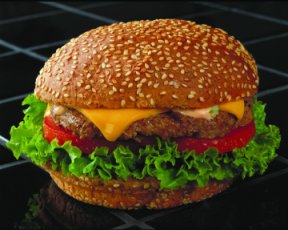How Carbs Can Make Burgers Safer
Here’s a new take on the meat-and-potatoes theme. Swedish scientists are adding the potato—or at least its starch—to ground meat prior to cooking. The combo doesn’t taste any different from an ordinary burger, say the researchers, but the potato additive dramatically limits the amount of carcinogens that forms while the meat cooks.

Most food-safety concerns associated with hamburger have focused on raw or undercooked beef as a vehicle for potentially lethal germs (SN: 10/20/01, p. 246). However, chemists have warned for years of another problem, carcinogens that form when a burger or other meat is cooked using an especially hot grill, fry pan, or broiler (SN: 11/28/98, p. 341).
At high temperatures, certain natural constituents of the meat—the simple sugar glucose, the amino acid creatinine, and additional free amino acids—can chemically react to form carcinogenic heterocyclic amines (HCAs). Typically, the longer meat cooks at a high temperature, the greater the production of HCAs. Indeed, low-temperature cooking or a quick searing may generate none of the carcinogens.
Because there’s no way to tell visually, by taste, or by smell whether HCAs lace cooked meat, food chemists have been lobbying commercial and home chefs to reduce the heat they use to cook meats. A few research teams have also explored treatments to protect meat while it cooks, mainly by keeping it moist (SN: 4/24/99, p. 264). Water loss during cooking can draw some of the HCAs’ building blocks to the meat’s surface, where temperatures are highest.
Kerstin Skog of Lund University and her coworkers now report that their novel potato treatment not only limits water loss in cooking burgers, but also largely shuts down HCA production.
Why carbs?
In the past, several studies noted diminished HCA production when a carbohydrate—some starch or sugar—was added to precooked meat. However, carbs vary dramatically in their structure, solubility, and other features that might affect cooked meat’s water retention. Until now, Skog’s team says, no one had attempted to systematically evaluate whether all carbs or just a few are protective.
So, the Lund researchers tested 11 different carbohydrates as potential additives. Four were various combinations of the simple sugars fructose and glucose. Others included wheat bran, potato fiber and starch, a starchy product made from corn, a cellulose-derived polymer of glucose, a pectin, and guar gum. Each of these materials is routinely added to foods for various purposes, such as to improve their juiciness, texture, taste, or aroma or to limit a product’s shrinkage during cooking.
One gram of carbohydrates was added per 100 grams of meat. The Lund scientists also laced all tested meat—except for some carbfree burgers used as controls—with trace quantities of salt and sodium tripolyphosphate (TPP), a food additive. Last year, they showed that the salt-TPP combo limited a burger’s moisture loss during cooking by more than 50 percent and cut the production of various HCAs by up to 50 percent. Those findings appeared in the July 15, 2003 Journal of Agricultural and Food Chemistry.
In its new study, Skog’s group again made uniform, 90-gram burgers—each roughly 90 millimeters in diameter. They grilled the meat for 5 minutes at 200°C in an appliance that simultaneously made contact with the top and bottom of the hamburgers. Afterward, a team member sliced the crust—typically about 30 grams of meat—off each burger and chemically analyzed the material.
Overall, the burgers treated with potato starch developed the lowest total quantity of HCAs in their crust, just 5.5 nanograms per gram of cooked meat, Skog’s team reports in an upcoming issue of the Journal of Agricultural and Food Chemistry. The next best performer was a fructose-glucose mix, which yielded roughly 8 ng/g. By contrast, the untreated burgers ended up with an HCA content of 60 ng/g, and the one laced with only salt and TPP yielded HCAs at 16 ng/g.
Only three other carb additives beat the salt-TPP combination: potato fiber, producing burgers with 10.2 ng of HCAs per gram of meat; wheat bran, producing 13.3 ng/g burgers; and the cellulose derivative, producing 14.7 ng/g cooked meat. Other additives allowed up to 40 ng of the HCAs to develop in a gram of meat.
Additional advantages
A patty’s weight loss during frying—attributable primarily to moisture loss—ranged from a low of about 25 percent, for burgers containing potato fiber, the corn-derived additive, or the salt-TPP combination, to about 45 percent for undoctored-meat patties and those containing the worst performing fructose-glucose mix. Weight loss in burgers containing the potato starch fell about midway in between: 36 percent.
What this means is that the HCA-fighting starch also produced a juicy burger.
Finally, the Swedish researchers mixed HCAs into solutions containing the various carbs and measured the degree to which each additive bound the HCAs. This experiment was meant to simulate what might happen when a person eats a carcinogen-laced burger.
Only the potato starch and the wheat bran bound the carcinogens in significant amounts, and the starch outperformed the bran. These findings are potentially important, the scientists note, because any HCA binding could limit the carcinogens’ uptake by the intestines.
Potato starch is inexpensive and readily available in grocery stores. Adding small amounts of it to meat before cooking “is a simple and effective way of reducing the amount of [HCAs],” the researchers conclude, and could be done easily by home cooks and commercial chefs alike.







